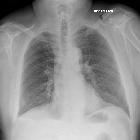Thoraxaufnahme in Exspiration







An expiratory chest radiograph can be taken in either a PA or AP projection, and can also be taken with a mobile/portable unit.
Chest radiographs may inadvertently be acquired in expiration (instead of inspiration), and this will affect interpretation with the cardiac silhouette appearing enlarged, and spurious basal opacities being the most common false positive findings .
Indication
They are used to help detect small pneumothoraces (although sensitivity is not increased over inspiratory chest radiographs ), and to assess for inhaled foreign bodies or gas trapping in COPD .
Patient position
- PA projection
- patient is erect facing the upright image receptor, the superior aspect of the receptor is 5 cm above the shoulder joints
- the chin is raised as to be out of the image field
- shoulders are rotated anteriorly to allow the scapulae to move laterally off the lung fields, this can be achieved by either:
- hands placed on the posterior aspect of the hips, elbows partially flexed rolling anterior or
- hands are placed around the image receptor in a hugging motion with focus on lateral movement of the scapulae
- shoulders are depressed to move the clavicles below the lung apices
- AP projection
- patient is erect facing the X-ray tube, the superior aspect of the receptor is 5 cm above the shoulder joints
- the chin is raised as to be out of the image field
- the arms are internally rotated to attempt to remove superimposition of the scapulae over the lung fields, although this is not always possible on an AP projection
- shoulders are depressed to move the clavicles below the lung apices
Patient position
- patient is erect facing the upright image receptor, the superior aspect of the receptor is 5 cm above the shoulder joints
- the chin is raised as to be out of the image field
- shoulders are rotated anteriorly to allow the scapulae to move laterally off the lung fields, this can be achieved by either:
- hands placed on the posterior aspect of the hips, elbows partially flexed rolling anterior or
- hands are placed around the image receptor in a hugging motion with focus on lateral movement of the scapulae
- shoulders are depressed to move the clavicles below the lung apices
Technical factors
- posteroanterior or anteroposterior projection
- suspended expiration
- centering point
- the level of the 7 thoracic vertebra, approximately the inferior angle of the scapulae
- collimation
- superiorly 5 cm above the shoulder joint to allow proper visualization of the upper airways
- inferior to the inferior border of the 12rib
- lateral to the level of the acromioclavicular joints
- orientation
- portrait or landscape
- detector size
- 35 cm x 43 cm or 43 cm x 35 cm
- exposure
- 100-110 kVp
- 4-8 mAs
- SID
- 180 cm
- grid
- yes
Image technical evaluation
The entire lung fields should be visible from the apices down to the lateral costophrenic angles.
- the chin should not be superimposing any structures
- minimal to no superimposition of the scapulae borders on the lung fields
- sternoclavicular joints are equal distant apart
- the clavicle are in the same horizontal plane
- the ribs and thoracic cage are seen only faintly over the heart
- clear vascular markings of the lungs should be visible
Practical points
Rotation of a chest radiograph can mimic common pathology processes and make it hard to produce a pertinent diagnosis.
The PA view is used to investigate a plethora of conditions and it is the radiographer's responsibility to ensure high-quality diagnostic images are achieved consistently.
The sternoclavicular joints are a sound indicator for positional rotation if one sternoclavicular joint is notably wider than the other, that respected side needs to be rotated toward the image receptor to correct rotation.
Patients with a longstanding history of emphysema or COPD will have abnormally long lungs compared to the general population, remember this when collimating superior to inferior.
Side marker placement is imperative, patients can have congenital conditions that mimic a mirrored image .
Remember to explain to your patient what you are about to do, that is ,ask them to take a breath in, take a breath out and hold it. Many times this gives the patient time to prepare and results in a better expiration.
Always remember to tell your patient to breathe again!
Siehe auch:

